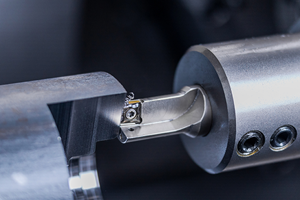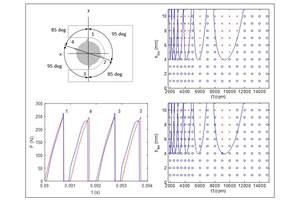Shop Standardizes On Cutter For All Of Its Face Milling In Steel
This 20-year-old contract shop is focused on short-run machining of large structural cast iron and hotrolled steel components for special machine tools.
Precise Tool and Manufacturing, Rochester, New York, is a 20-year-old contract shop focused on short run machining of large structural cast iron and hot rolled steel components for special machine tools designed and built for the printing and metalworking industries. Typical components include machine crossties and sideframes that are usually up to 6 feet in length and produced in lots of fewer than 25 pieces.
For almost all of the custom machineframe components the company produces, face milling operations are required to reduce incoming stock to required dimensions. To do this work and keep up with demand, the company uses a total of 26 different machine tools, including Mazak 30hp vertical machining centers, 30hp horizontal milling machines, and Mazak horizontal machining centers deployed in a flexible manufacturing system. Each machine is equipped with one face mill for roughing and another for finishing.
Because face milling is both an essential and major part of the production operations performed at Precise Tool and Manufacturing, the efficiency of the cutters used to meet part print requirements is key to the company's bottom line. For that reason, Precise conducted extensive comparison tests of face mills offered by six different cutting tool manufacturers, including the new Octomill cutter recently introduced by Carboloy Inc., Detroit, Michigan. Based on results of the testing which culminated in a decisive runoff between the Octomill and a competitive supplier's square shoulder cutting face mill, Precise decided to standardize on the new Carboloy cutter for all of its face milling requirements in steel.
The Octomill face mill adopted by Precise is best distinguished by its 45-degree ultrahigh positive geometry and use of unique octagonal inserts with eight cutting edges. The cutter is available in two versions that offer broad versatility. A general-purpose design, using 7 mm inserts, provides high-performance face milling, slotting, and profile milling. A lighter duty design, using 5 mm inserts, also performs these operations, but can be used for plunging, ramping, and helical interpolation. With both cutter versions, two cutting edges can be engaged simultaneously to provide deeper cuts, if required, than when only a single edge is engaged.
Following its adoption at Precise as the plantwide face mill of choice, the Octomill cutter was quickly put into production use in an application run on a Mazak 30hp vertical machining center. The workpiece to be machined was a hotrolled steel square bar measuring 4 inches on each side and 10 feet long. Machining requirements were to remove 0.250-inch of metal from each side, reducing the bar dimensions to 3.5 inches square, while meeting surface finish requirements of 60 rms.
The Octomill face mill selected for the application was a general-purpose 6-inch diameter cutter using 10 inserts (7 mm) in Carboloy's T25M standard milling grade and ME15 chipgroove geometry. Machining parameters were set at a spindle speed of 360 rpm, a cutting (surface) speed of 560 sfm, and a feed rate of 0.060 ipr. At these parameters and using high-pressure coolant, an initial roughing cut at 0.190 inch, and a followup semi-finishing cut at 0.060 inch, were performed on each of the four bar sides. All required machining was completed in nine minutes.
By comparison, the roughing face mill previously used in these operations was limited to a spindle speed of 287 rpm, a cutting speed of 450 sfm, a feed rate of 0.048 ipr, and a 0.080-inch depth of cut. Taking three passes on each of the four sides at these parameters, the previous cutter took 25 minutes to complete required rough machining only. Following this, another cutter had to be used to complete the machining with a final finishing pass on each of the four sides.
Unlike the previously used roughing cutter, the Octomill face mill easily met the 60rms surface finish requirements with its own semi-finishing pass thereby eliminating the need for a subsequent operation with a finishing cutter. According to Carboloy sales and service representative Doug Henderson, that capability is due to the cutter's innovative insert geometry. "The inserts have special curved cutting edges that create a wiper action," Mr. Henderson notes, so users can rough and finish with the same insert and get outstanding surface finish.
Since starting to use the Octomill face mill for the face milling operations on the hot rolled steel square bar, Precise Tool and Manufacturing has been able to complete all required processing of two of the parts per shift, compared to only one part per shift previously. At the same time, the company has dramatically reduced insert consumption and costs for the milling operations. Using the Octomill face mill, just one cutting edge is needed to machine all four sides of two parts (8 sides), reducing indexing requirements to just one per shift. By contrast, the previous roughing cutter machined only two sides of one part per cutting edge, requiring two indexes per part and four per shift. Moreover, the octagonal inserts used with the Octomill cutter provide eight cutting edges, in contrast to the four edges provided by the square milling inserts used with the previous conventional 45-degree face mill. In all, a single set of inserts used with the Octomill face mill provides eight times the tool life of inserts used with the previous cutter.
According to Derek Giles, Carboloy's manager for rotating tool products, the capabilities of the Octomill cutter are the result of a major product development effort. "We set out to benchmark the next generation of ‘supershear' 45-degree high positive face mills," Mr. Giles says. "Our objective was to engineer a new generation face mill that would provide high productivity in virtually any workpiece material, unmatched application versatility, excellent surface finish, and unprecedented operating economy."
To provide operating economy, the Octomill uses special octagonal inserts that have twice the cutting edges of the square milling inserts used with conventional 45-degree face mills reducing insert costs per index by as much as 50 percent. The inserts are available in specially engineered grades and geometries that provide superior metal removal and tool life.
For high productivity, the Octomill incorporates advanced positive geometry and a 25-degree insert clearance angle that reduce cutting forces and horsepower requirements, and permit higher metal removal rates. Extra thick inserts with a wide 135-degree corner angle provide added security and strength, allowing more aggressive feed rates at full depths of cut. The inserts are available in 5 geometries and 8 cutting grades, and are designed to machine almost any workpiece material. A patented integrated anvil is incorporated into the inserts to minimize possible cutter body damage in the unlikely event of insert failure.
Octomill cutters in the general-purpose series are currently available in diameters from 2.5 inches to 6 inches in a fixed pocket design, and use 7 mm inserts with a 0.190-inch single edge depth of cut capability. (Deeper cuts of up to 0.300 inch and more can be taken by engaging two cutting edges simultaneously.) The general-purpose cutters are recommended for applications requiring heavier feed rates from 0.004 to 0.016 ipt.
Cutters in the lighter duty series are available in diameters from 1.25 inches to 5 inches, and use 5 mm center-locking octagonal inserts with a 0.130-inch single edge depth of cut capability. These cutters are recommended for applications covering feed rates from 0.002 to 0.007 ipt.
Related Content
All-Around Mill Improves Productivity and Cost for Valve Job
Adopting a mill with a double-negative rake and pockets compatible with multiple insert geometries enabled Progressive Metal Service to increase feed and lower scrap rates for a valve.
Read MoreCeratizit's Updated Tooling Solutions Improve Machining Performance
The company has upgraded its EcoCut indexable inserts lineup, as well as introduced two new toolholding and workholding solutions.
Read MoreThe Impact of Cutting Teeth Spacing on Machining Stability
Many cutter designs are available, and variable teeth spacing (or variable pitch) cutters can be used to influence milling stability. Let’s discuss why teeth spacing affects stability.
Read More10 Tips for Titanium
Simple process considerations can increase your productivity in milling titanium alloys.
Read MoreRead Next
3 Mistakes That Cause CNC Programs to Fail
Despite enhancements to manufacturing technology, there are still issues today that can cause programs to fail. These failures can cause lost time, scrapped parts, damaged machines and even injured operators.
Read MoreThe Cut Scene: The Finer Details of Large-Format Machining
Small details and features can have an outsized impact on large parts, such as Barbco’s collapsible utility drill head.
Read More











.png;maxWidth=300;quality=90)

















.png;maxWidth=970;quality=90)